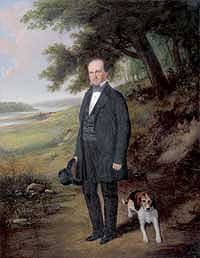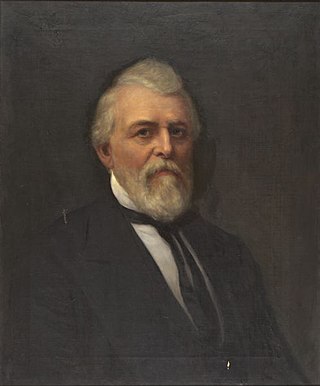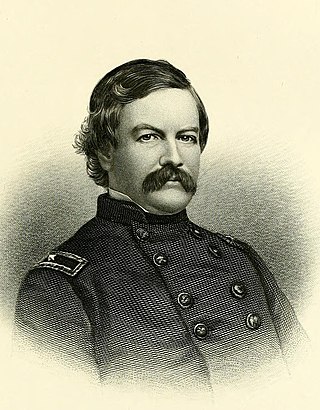Related Research Articles

The Territory of Wisconsin was an organized and incorporated territory of the United States that existed from July 3, 1836, until May 29, 1848, when an eastern portion of the territory was admitted to the Union as the State of Wisconsin. Belmont was initially chosen as the capital of the territory. In 1837, the territorial legislature met in Burlington, just north of the Skunk River on the Mississippi, which became part of the Iowa Territory in 1838. In that year, 1838, the territorial capital of Wisconsin was moved to Madison.

James Taylor Lewis was an American lawyer and politician who served as the 9th Governor of Wisconsin (1864–1866). Prior to his election as governor, he was the 7th Secretary of State of Wisconsin (1862–1864) and the 4th Lieutenant Governor of Wisconsin (1854–1856), and served one year each in the Wisconsin State Senate (1853) and Assembly (1852).

Morgan Lewis Martin was a delegate to the United States House of Representatives from Wisconsin Territory during the 29th United States Congress (1845–1847). He also served as a member of the Wisconsin State Senate and Wisconsin State Assembly, and served as a county judge in Brown County, Wisconsin.

Charles Grandison Williams was an American lawyer and Republican politician. He represented the state of Wisconsin for ten years in the United States House of Representatives, from 1873 to 1883, and was chairman of the House Foreign Affairs Committee.

Moses McCure Strong was an American lawyer, politician, businessman, and Wisconsin pioneer. He was one of the framers of the Constitution of Wisconsin, a member of the territorial legislature, and United States Attorney for the Wisconsin Territory under President Martin Van Buren. After Wisconsin achieved statehood, he was speaker of the Wisconsin State Assembly during the 3rd Wisconsin Legislature (1850).

Levi Hubbell was an American lawyer, judge, and politician. He was the first Wisconsin state official to be impeached by the Wisconsin State Assembly in his role as Wisconsin circuit court judge for the 2nd circuit. He was also Chief Justice of the Wisconsin Supreme Court prior to the 1852 law which organized a separate Supreme Court, and he later became the first United States Attorney for the Eastern District of Wisconsin. He served one term each in the Wisconsin State Assembly and New York State Assembly.

Harrison Carroll Hobart was an American lawyer, Democratic politician, and Union Army officer during the American Civil War. He was the 2nd speaker of the Wisconsin State Assembly, and served in the 1st Wisconsin Legislature as a member of the Wisconsin Senate. He was the Democratic nominee for Governor of Wisconsin in 1859 and 1865.
Wiram Knowlton was an American politician and jurist from Wisconsin. He was a Wisconsin Circuit Court Judge and ex officio Justice of the pre-1853 Wisconsin Supreme Court.

Edward Vernon Whiton was an American lawyer, jurist, and Wisconsin pioneer. He was the first elected Chief Justice of the Wisconsin Supreme Court, serving on the Supreme Court from its creating in 1848 until his death in 1859. He had previously served in the Wisconsin Territory legislature and was a framer of Wisconsin's constitution.

Edward George Ryan was an Irish American immigrant, lawyer, and Wisconsin pioneer. He was the 5th chief justice of the Wisconsin Supreme Court.
Squire Park Coon was an American lawyer, politician, and Wisconsin pioneer. He was the 2nd Attorney General of Wisconsin and served as a Union Army officer in the American Civil War.
John Hawkins Rountree was an American farmer, businessman, politician, and Wisconsin pioneer. He was the founder of Platteville, Wisconsin, and was instrumental in the early development of that village. He was also one of the founders of the Northwestern Mutual Insurance Company, and remained a director in the company until his death. In politics, he represented Grant County for five years in the Wisconsin Legislature, and was a delegate to Wisconsin's 2nd constitutional convention in 1847.
Marshall Mason Strong was an American lawyer, newspaper editor, businessman, and politician from Racine, Wisconsin who served on the Wisconsin Territorial Council of the Wisconsin Territorial Legislature in 1838–1839 and 1844–1847 from Racine County, including a term as President of the Council. He later spent a single one-year term in 1849 as a Free Soil Party member of the Wisconsin State Assembly from that county.

Stoddard Judd was an American physician, politician, and Wisconsin pioneer. He served 4 years in the Wisconsin Legislature, representing Dodge County. Earlier, he served three terms in the New York State Assembly.

David Noggle was an American politician, lawyer, and jurist. He was chief justice of the Supreme Courtof the Idaho Territory from 1869 to 1874, appointed by President Ulysses S. Grant. Earlier, he served as a member of the Wisconsin State Assembly and a Wisconsin circuit court judge.
Hollis Latham was a Wisconsin farmer and politician.
Alonzo David Dick was a Brothertown Indian farmer, tavernkeeper, and postmaster from Brothertown, Wisconsin,. As a member of the Whig Party, he served one term in the Wisconsin State Assembly, representing Calumet County.
The First Legislative Assembly of the Wisconsin Territory convened from October 25, 1836, to December 9, 1836, and from November 6, 1837, to January 20, 1838, in regular session. The Assembly also convened in special session from June 11, 1838, to June 25, 1838.
William Shew was a farmer and businessman from Oak Creek, Wisconsin and Cordova, Illinois who served multiple terms in the Wisconsin Territory House of Representatives representing Milwaukee County, and was Speaker of the House of that body during the first (1847) session of the 5th Wisconsin Territorial Assembly, as well as holding various local government posts.
John Devine Seaver was an American farmer, politician, and Wisconsin pioneer. He served one term in the Wisconsin State Assembly, representing northwestern Rock County as a Whig during the 1851 term.
References
- ↑ Williams, Edwin (1836). The New York Annual Register. New York City: Edwin Williams. p. 427. Retrieved May 13, 2020.
- ↑ Heg, J. E., ed. (1882). "Annals of the Legislature". The Blue Book of the State of Wisconsin (Report). State of Wisconsin. pp. 161–174. Retrieved May 12, 2020.
- 1 2 "Died". Janesville Daily Gazette. November 6, 1847. Retrieved May 13, 2020.
- ↑ The Territorial Papers of the United States. Vol. 27. Washington, D.C.: The National Archives. 1969. pp. 88, 200, 230, 344, 350. Retrieved May 13, 2020.
- ↑ "Janesville Female Seminary". Janesville Daily Gazette. November 8, 1845. Retrieved May 13, 2020.
- ↑ "Died". Buffalo Morning Express. October 25, 1847. Retrieved May 13, 2020.
- ↑ "Obituary". Janesville Daily Gazette. November 1, 1845. Retrieved May 13, 2020.